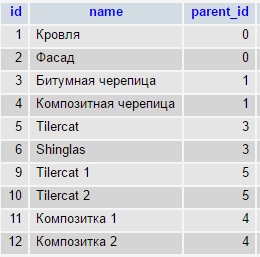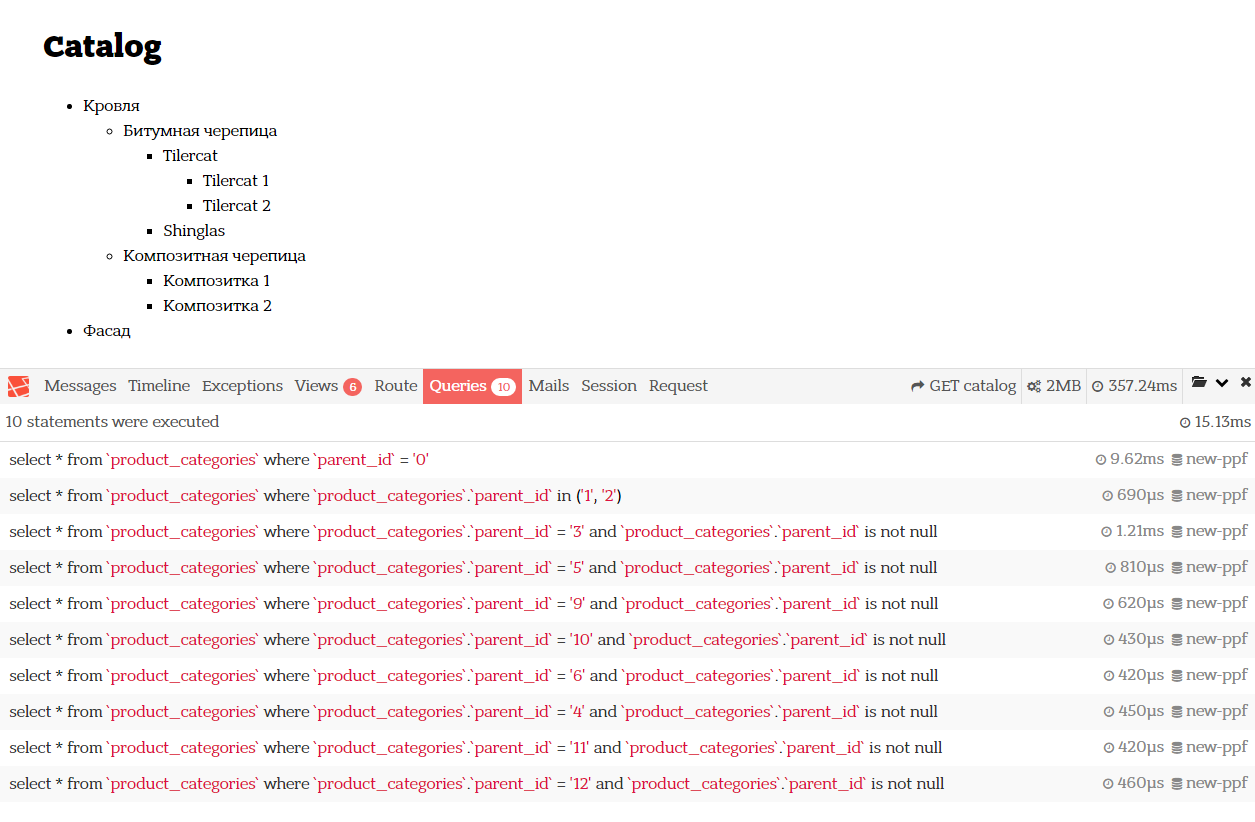Answer the question
In order to leave comments, you need to log in
Laravel category tree. How to reduce the number of queries in the database?
In general, there is a table of categories  .
.
Model code
class ProductCategory extends Model
{
protected $table = 'product_categories';
public function ProductCategory(){
return $this->hasMany($this, 'parent_id');
}
public function rootCategories(){
return $this->where('parent_id', 0)->with('ProductCategory')->get();
}
}class ProductCategoryController extends Controller
{
public function index(ProductCategory $productCategory){
$rootCategories = $productCategory->rootCategories();
return view('layouts.catalog', ['rootCategories' => $rootCategories,]);
}
}<h1>Catalog</h1>
<ul>
@foreach($rootCategories as $rootCategory)
<li>{{ $rootCategory->name }}</li>
@if($rootCategory->ProductCategory->count() > 0)
@include('layouts.partials.treeChildMenu', ['categories' => $rootCategory->ProductCategory])
@endif
@endforeach
</ul><ul>
@foreach($categories as $category)
<li>{{ $category->name }}</li>
@if($category->ProductCategory->count() > 0)
@include('layouts.partials.treeChildMenu', ['categories' => $category->ProductCategory])
@endif
@endforeach
</ul>
Answer the question
In order to leave comments, you need to log in
Select everything with one request and build a tree with a recursive function, if PHP has not been forgotten yet.
example
If you're using PostgreSQL, look into recursive subqueries .
If it's not PostgreSQL, then you can try building a tree from "raw data" directly in PHP (as ThunderCat tells you ).
But in general, personally, I would first evaluate the frequency of category changes in the catalog and the total number of categories (data volume), and in accordance with this information, I would choose a more appropriate model for storing trees in the database. There are four
such basic models : Adjacency list, Nested Sets, Materialized Path and Closure Tables (can be considered as development of Adjacency List) plus their variations.
Each type of model can serve to optimize data fetching from tree structures in the database.
There are also libraries for Laravel:
Nested Set
Closure Tables
For Adjacency List (your current implementation), just sort the data yourself, or try this package .
I would advise you to use a Nested Set tree instead of a regular tree. In pure PHP, how this is done is well written here www.getinfo.ru/article610.html. There is a good package for Laravel https://github.com/etrepat/baum (I use it myself).
An example of my table
Advantages of this approach - the entire branch can be obtained with one query.
Cons More complicated insert and update.
For some time now, I have been storing directories and pages in just such a tree - to get bread crumbs on a page - 1 request. Get directory tree - 1 request.
Add a couple more levels of loading with('ProductCategory', 'ProductCategory.ProductCategory', 'ProductCategory.ProductCategory.ProductCategory') to with, otherwise you have lazy loading with a large number of requests starting from the second level. There will be a couple of extra requests, but this is not critical for most projects.
If you load the entire tree, then you can select it as a whole, and then collect this tree on the php side.
I used to do this too (normal AL and queries to the database recursively). Brakes started on the kilometer tree. Altered on single request variant as already advised. In practice, it turned out that the brakes were not because of this, but because of the rendering of the tree. On a server with mysql_cache configured and a rarely changing category table, the difference between 1 and 200 requests turned out to be nonsense, but it is there. + someone will be "lucky" to wait for the tree when the cache is reset.
I'll attach my version (just for eloquent), two classes, add them somewhere and rename them as you need.
class Tree
{
private $builder;
private $parentIdFieldName = 'parent_id';
private $nodesById = [];
private $nodesByParent = [];
public function __construct($builder)
{
$this->builder = $builder;
}
public function parentIdField($name)
{
$this->parentIdFieldName = $name;
return $this;
}
/**
* @return Output
*/
public function get()
{
$nodes = $this->builder->get();
foreach ($nodes as $node) {
$this->nodesById[$node->id] = $node;
$this->nodesByParent[$node->{$this->parentIdFieldName}][] = $node;
}
$output = new Output;
$output->parentIdFieldName = $this->parentIdFieldName;
$output->nodesById = $this->nodesById;
$output->nodesByParent = $this->nodesByParent;
return $output;
}
}class Output
{
public $parentIdFieldName = 'parent_id';
public $nodesById = [];
public $nodesByParent = [];
public function getNode($id)
{
if (!isset($this->nodesById[$id])) {
$this->nodesById[$id] = [];
}
return $this->nodesById[$id];
}
public function getSubnodes($id)
{
if (!isset($this->nodesByParent[$id])) {
$this->nodesByParent[$id] = [];
}
return $this->nodesByParent[$id];
}
private $branch;
public function getBranch($id))
{
if (isset($this->nodesById[$id])) {
$this->branch = [];
$this->branchRecursion($id);
return array_reverse($this->branch);
}
}
private function branchRecursion($id))
{
$this->branch[] = $this->nodesById[$id];
if ($this->nodesById[$id][$this->parentIdFieldName] > 0) {
$this->branchRecursion($this->nodesById[$id][$this->parentIdFieldName]);
}
}
}class Test
{
private $tree;
private $output;
public function treeView()
{
$builder = new ProductCategory; // тут можно дописать что-нибудь типа orderBy('position') или where('enabled', true); главное так чтобы любые ограничения в первую очередь исключали вышестоящие узлы (ни в коем случае не исключали нижестоящие не исключая нижестоящие), иначе дерево получится кривое - недостаток способа
$this->tree = (new Tree($builder))->get();
$this->treeRecursion(0); // здесь уже можно указать ид корневого узла для дерева на выходе
return implode('<br>', $this->output);
}
private $level = 0;
private function treeViewRecursion($id)
{
$node = $this->tree->getNode($id);
$subnodes = $this->tree->getSubnodes($id);
$this->output[] = str_repeat('--', $this->level) . ' ' . $node->name;
if ($subnodes) {
$this->level++;
foreach ($subnodes as $subnode) {
$this->treeViewRecursion($subnode->id);
}
$this->level--;
}
}
}
print (new Test)->tree();Use MPTT . Allows you to do almost all the necessary operations in 1 request: selecting a family, subtree, sons, leaves, descendants, ancestors.
It would be good for MySQL to confirm that the category table is created with InnoDB support. If so, then check if there is, and if not, then add the index
CREATE INDEX IX_product_categories_NC1 ON product_categories ( parent_id, name, id );
Models/Catalog.php
public static function getCategories() {
// Получаем одним запросом все разделы
$arr = self::orderBy('name')->get();
// Запускаем рекурсивную постройку дерева и отдаем на выдачу
return self::buildTree($arr, 0);
}
// Сама функция рекурсии
public static function buildTree($arr, $pid = 0) {
// Находим всех детей раздела
$found = $arr->filter(function($item) use ($pid){return $item->parent_id == $pid; });
// Каждому детю запускаем поиск его детей
foreach ($found as $key => $cat) {
$sub = self::buildTree($arr, $cat->id);
$cat->sub = $sub;
}
return $found;
}public function index() {
$categories = Catalog::getCategories();
return view('Catalog.index')
->withCategories($categories);
}<ul>
@foreach($categories as $category)
<li>
{{$category->name}}
@if($category->sub->count())
@include('catalog.partial.show', ['categories' => $category->sub])
@endif
</li>
@endforeach
</ul>Didn't find what you were looking for?
Ask your questionAsk a Question
731 491 924 answers to any question